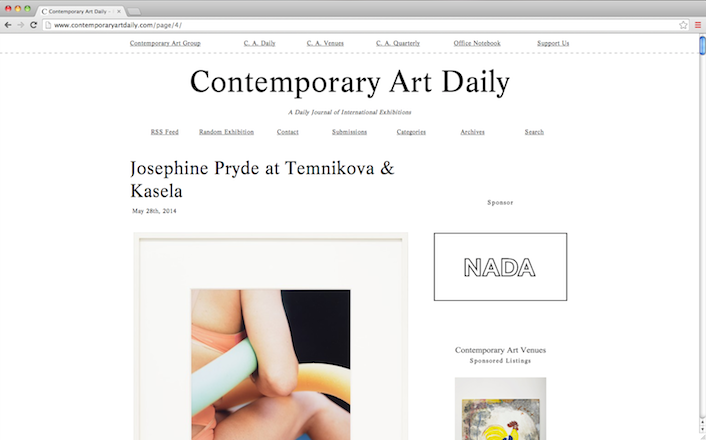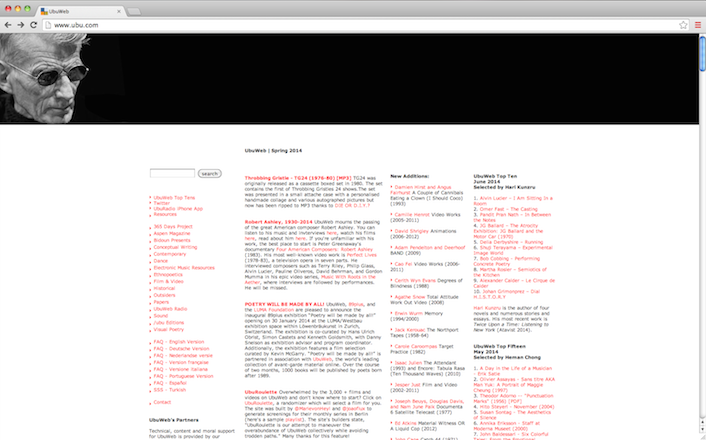CURRENT ISSUE
CURATING THE INTERNET
moderated by Karen Archey

KAREN ARCHEY: As the verb “to curate” has spilled into popular usage in recent years (“curate your closet!”, etc.), it has become a broader term, a synonym for the action of accumulating things: objects, texts, images, artworks, words, etc. Would you describe your activity to be curatorial in nature?
VVORK (Oliver Laric): We thought of VVORK as an ongoing exhibition, continuously changing with each work being added.
CONTEMPORARY ART DAILY (Forrest Nash): We actually had a conversation in the office about this not too long ago. Are we doing something curatorial, or editorial, or something else? We realized that we all preferred different words for different reasons. I’d say Daily has both a curatorial aspect and a journalistic/editorial aspect.
METAHAVEN: The term curatorial presupposes the luxury of a certain distance from things and events as they happen. It is a distance that we often don’t have because we continually produce work. But whenever you invite other people to take part in a collaboration, or whenever you look back at what you’ve done, then you are indeed curating. This occurs frequently — but it is not what defines our practice.
E-FLUX (Anton Vidokle): Some of our activity is indeed curatorial: primarily exhibitions and screenings. I would say, and Julieta may or may not agree with me, that our approach is primarily that of artists, who have traditionally done many things in addition to making art objects: like organizing exhibitions, writing and publishing, teaching, running organizations and so forth. In a sense this is a long tradition that goes back all the way back to someone like Gustave Courbet.
E-FLUX (Julieta Aranda) Personally, I don’t see what we do as part of a curatorial milieu, even though the end product crosses over. For me, we are artists, with a fantastically omnivorous approach, and we are acting as such. It has been interesting to see the changes in the conversation that involves artists that work in an expanded field — and here I include people that are interested in social practice, relational aesthetics, pedagogy, discursive models, curatorial endeavors and entrepreneurial capitalist schemes. At the end all these are modes of circulation (some of them good, some rather shitty), but circulation nonetheless.
K-HOLE (Dena Yago): Our platform looks to consumer trends, and attempts to identify the larger motivating forces behind why and how decisions are being made. This is why we focused on anxiety and individuality in our past two reports. This is not a curatorial practice; it’s more along the lines of sociological or anthropological thinking.
UBU WEB (Kenneth Goldsmith): UbuWeb is a false archive, cobbled together on the whims of a poet who knows nothing about his subject. It’s much closer to a Wunderkammer than a curatorial project. It is often mistaken for an institution, but that’s mostly due to people’s need to create and reify authoritative power structures.
FIRST LOOK (Lauren Cornell): In a sense, curating for First Look mirrors the process of organizing a solo project in a gallery space. It’s very focused, and involves reaching out to individual artists; deciding if we’ll commission a work or present a preexisting project; discussing the language to describe the work and considering how and if we can commit to preserving it. Most of the artists are relatively early in their career and there is not an extensive amount of interpretation on their work available.

KA When creating your platform, did you look at any preexisting models for inspiration, online or in meatspace? Do you consider your collective creative output to have similar or different impact in online versus IRL space, or is the distinction between the virtual and physical even a useful one to you?
VV: Before VVORK we were publishing a print magazine that existed in other print magazines. We did not have print or distribution costs but there were always negotiations to get space in publications. When we came across blogs such as boingboing.net it seemed liberating to just publish without geographic restrictions and with marginal costs. It was also a cheap alternative to an off-space without many of the hassles attached to real estate. The website had the potential to serve as a platform for artists without gallery support from inside and outside our circle of friends. The distinction between virtual and physical might be valid but we were more interested in the reversal or flattening of the binary of primary and secondary experiences.
MH: Virtual versus physical is not a useful distinction so much, at least not with regard to how the Internet affects human life. Human interactions mediated through computers and smartphones are not “virtual realities,” but fully experienced realities of which the tragedy, or loss, is that they can also be accounts of distance. The internet and the cloud are often the canvas for our projects but the physical presence of our work is equally important. The weightlessness of online work is pleasant but so can be the physical presence of objects. A lot of our work is geared toward surface or screen, and this type of work can be experienced in both domains in similar ways.
E-F (AV): In a sense, Fluxus was an indirect influence. I was always fascinated with how George Maciunas tried to construct a certain kind of sustainable economy for his group or movement that would facilitate the production and dissemination of their works.
K-H: We distribute the reports as freely downloadable PDFs, and we try to keep them in that format. General Idea’s work really inspires us; after our first report we were made aware of a book of Australian artist-made advertisements titled “Knowledge Keeps Like Fish” that resonated. And K-HOLE being primarily writing-based, we definitely look to other writers like William Gibson and blogger Venkatesh Rao.
UW: UbuWeb grew willy-nilly out of my collecting habits — weird LPs and dusty old concrete poetry books. When we began in 1996, there were no online models for this. So I just took what was on my shelves and digitized it and threw it on the web. Today, all my collecting is done online — I haven’t set foot in a record shop in decades; it’s all from file-sharing pirate sites. I have more than I’ll ever be able to use.
FL: There are countless examples of online exhibition — by artists, arts organizations, tech companies and those not considered fine artists. I watched and participated in this history before getting involved with First Look. A way in which I wanted to distinguish this program was to have the projects, when possible, unfold both online and off. I don’t want to force things into the gallery but I want to explore the different dimensions and ways they can be shown, and to make a space for online practices within a museum.

KA: Do you think that the context of the Internet generally allows for a reinvention of curatorial practice — and even artistic practice — or have we seen traditional models of creative production uncritically recapitulated online?
VV: It’s getting better. When we started VVORK there were fewer personal websites by artists and many were restrictive in their presentation, showing small images with copyright statements and watermarked video snippets.
MH: No doubt. But curatorial practice depends on a wide variety of factors, including the network of a curator, the institutional and financial means backing that practice, and many other things.
FL: This is a complicated question: Curatorial invention online can be drastic but is also often subtle and impermanent, as forward-thinking gestures are quickly absorbed or over-written by the sea change of commercial, popular or artistic movement constantly taking place online. VVORK, for example, predated Tumblr, and was a new way to see and think about art, at the time, but its “reinvention” may be hard to see now. Often big projects with big money intending to make big change fail because they don’t map to peoples’ behaviors or desires.
KA: Within the last year or so, Contemporary Art Daily has been identified as a major force in the contemporary art world, one that has changed how artists produce art. As the person at the helm of CAD, how do you respond to this criticism?
CAD: The idea that we would be influencing what happens in the studios of artists is almost always framed negatively, which might be why you used the word “criticism.” This often comes up, particularly in relation to the idea that we influence what happens in the studios of younger artists. The idea is usually that artists would use our project as a way to discern the tastes of the art world in general so that they can adapt to them, or worse, that they would strategically make exhibitions that they think we will publish, which will help their career. I’ve only ever heard secondhand that this happens, so I can’t speak to whether or not it happens enough to be relevant. I would hope that over the long term it will be clear who is deeply invested in their work and who is merely echoing a perceived consensus about what they should make. That said, I think we might be influencing artists’ decisions in a more positive way, by giving them much broader access to discourse surrounding international exhibitions. It’s now radically easier to be “in the know” in a way that I hope empowers artists, not least by allowing them to feel closer to a world notoriously described as exclusive.
KA: Considering Metahaven’s activities span graphic design, essay-writing, social media feeds, public speaking and general consciousness-raising, what holds your practice together? In what ways do you engage with the internet that extend beyond platform and content?
MH: The Internet is a condition, a lens, through which to look at anything. It provides so much of the visual material of everyday life and so it is not a neutral lens but one tainted with interesting and relevant presets. One of our most recent projects in development, which deals with an unrecognized state in North Africa, is an extreme example of the manner in which a space that is so explicitly not about the Internet, and severely underrepresented on it, can be brought to the attention by looking at it through the perspective of Internet. We can’t be more explicit about it at this point but much of our work is not about the internet or on the internet but made by the Internet.



